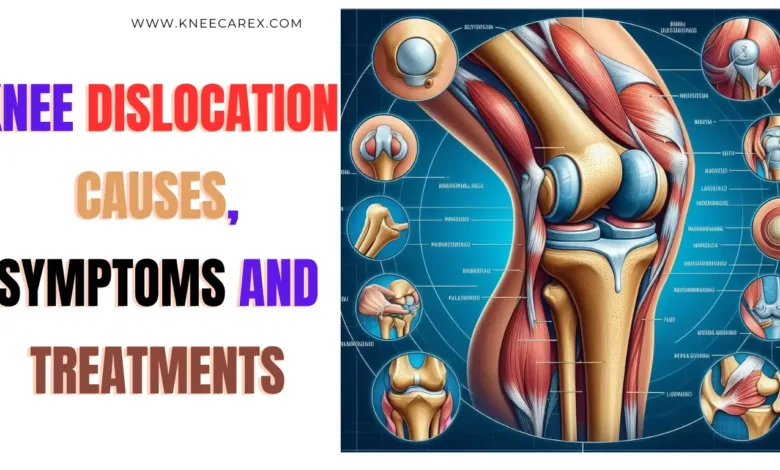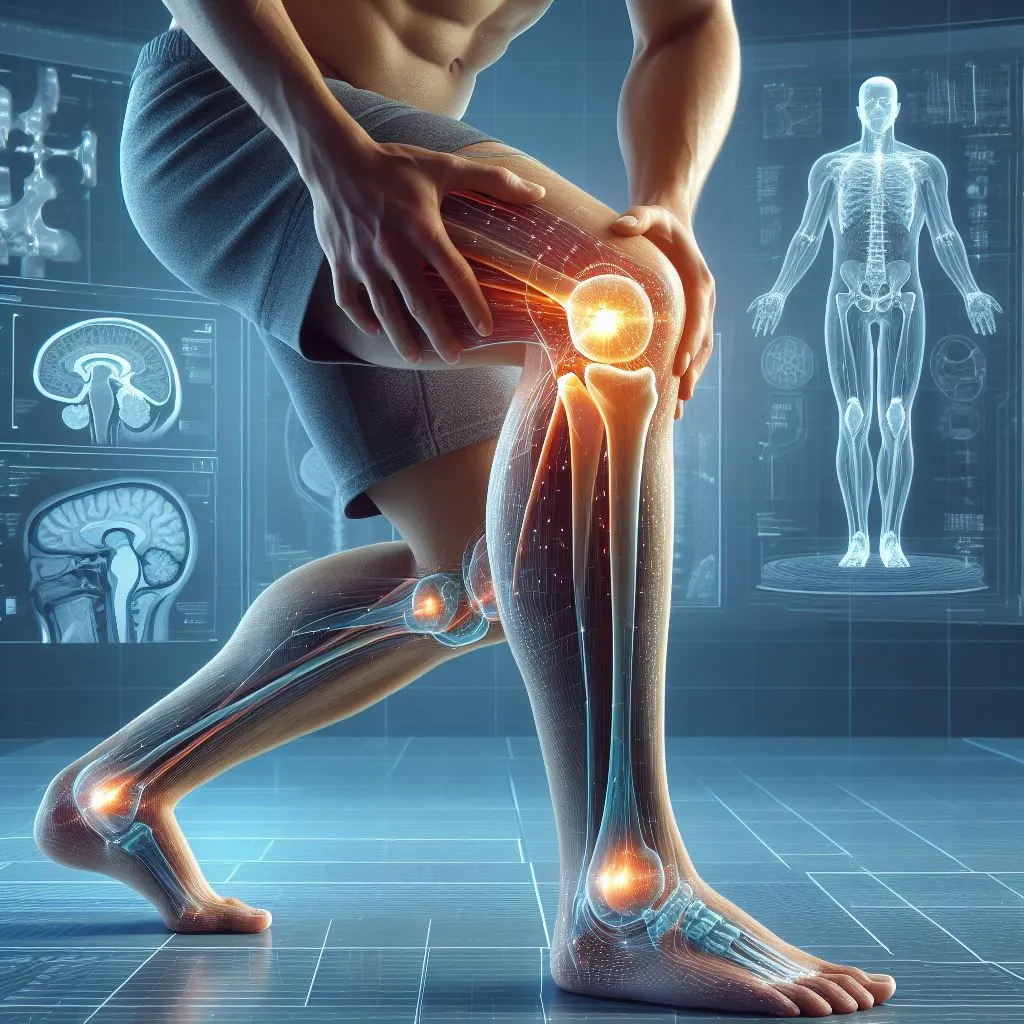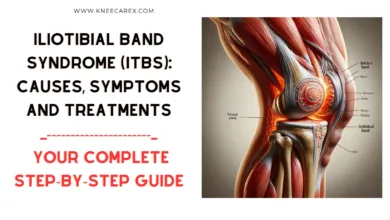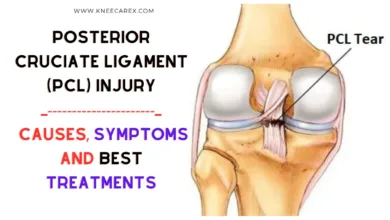Knee Dislocation: Causes, Symptoms and Treatments

Imagine feeling sick all of a sudden, like your knee gives way under you, leaving you unable to support your weight and in a lot of pain. A dislocated knee is a terrible injury that could be deadly. It can happen in a car accident or during sports, and the results can be terrible. This article will look at the complicated web of causes, symptoms, and treatments for knee dislocations to shed light on this challenging but essential topic.
Contents
- 1 Definition of Knee Dislocation
- 2 4 Best Knee Brace for Dislocated Kneecap | Right Knee Brace for Patella Dislocation
- 3 Causes of Knee Dislocation
- 4 Symptoms of Knee Dislocation
- 5 Diagnosis and Treatment Options
- 6 Rehabilitation and Recovery
- 7 Prevention of Knee Dislocation
- 8 FAQ’s
- 8.1 Can you still walk with a dislocated knee?
- 8.2 How do you fix a dislocated knee?
- 8.3 What are the three most common injuries to the knee?
- 8.4 What does a dislocated knee feel like?
- 8.5 What is the best treatment for a dislocated knee?
- 8.6 How long does it take for a dislocated knee to heal?
- 8.7 Can you fix a dislocated knee without surgery?
- 8.8 Is it OK to walk on a dislocated knee?
- 8.9 What is the most common way to dislocate a knee?
- 8.10 What is a subluxation of the knee cap?
- 8.11 What is it called when you almost dislocate your knee?
- 8.12 Can you still walk with a dislocated knee?
- 8.13 Can you move your knee if it’s dislocated?
- 8.14 What are the two types of dislocations in the knees?
- 8.15 What is the pain level of a dislocated knee?
- 8.16 What is the prognosis for a dislocated knee?
- 8.17 What is the fastest way to heal a dislocated knee?
- 8.18 How do you straighten a dislocated knee?
- 8.19 Should I bend my knee after a dislocation?
- 8.20 What exercise is good for knee dislocation?
- 8.21 How do you fix a partially dislocated knee?
- 8.22 Can you walk on a partially dislocated knee?
- 8.23 How long does a partial knee dislocation take to heal?
- 8.24 Can you fix a dislocated knee without surgery?
- 8.25 How long does it take to walk on a dislocated knee?
- 8.26 How long should you wear a knee brace after a dislocation?
- 8.27 When can you return to work after a dislocated knee?
- 8.28 Can you walk without crutches on a dislocated knee with a splint?
- 9 Conclusion: Knee Dislocation
Definition of Knee Dislocation

One important thing to know about knee dislocation is that it can hurt blood vessels and nerves in the joint at the same time. This could negatively affect both immediate medical care and long-term ability to work. Because of the high forces needed to cause a knee dislocation, there may also be fractures or damage to soft tissues, making treatment even more difficult. It is essential to understand these complexities to give complete care that considers not only the knee’s structural stability but also its neurological and vascular health.
4 Best Knee Brace for Dislocated Kneecap | Right Knee Brace for Patella Dislocation
Causes of Knee Dislocation
A knee fracture is a severe injury that doesn’t happen very often. It usually occurs after a high-impact event, like a car or sports accident. A sudden and robust twisting of the knee joint is one of the main reasons for knee dislocation. This can cause the bones and tendons to move out of place. A knee dislocation can also happen from direct hits to the knee or from bending and straightening the joint too much.
Damage to ligaments, especially breaking or stretching of essential structures like the anterior cruciate ligament (ACL) or posterior cruciate ligament (PCL), is another important cause of knee dislocation. This weakening of the supporting ligaments can make it much more likely for the knee to dislocate, which makes it more likely to get hurt. It’s essential for people who do high-impact activities to be aware of these possible reasons and take the proper precautions to lower their risk of dislocating their knee.
Symptoms of Knee Dislocation

In addition to the pain and instability that they experience physically, a lot of patients also express fear and mental distress over their injuries. An individual’s mental health can be significantly impacted by the unexpected trauma of a knee dislocation since they are concerned about their prognosis and future mobility. This feature emphasizes how crucial it is to provide patients with knee dislocations with comprehensive care, attending to both their physical and psychological needs during this trying period.
Diagnosis and Treatment Options
Medical experts frequently use a combination of physical examination, imaging tests (MRIs and X-rays), and a detailed review of the patient’s medical history to diagnose knee dislocation. A thorough approach can accurately determine the amount and kind of knee injury, which helps determine the best course of action for therapy.
Regarding knee dislocations, a multimodal strategy is frequently used in therapy. This may entail immobilizing the knee joint with a brace or cast right away to facilitate healing. Physical treatment is also essential to restore strength and function to the injured joint and surrounding muscles. Furthermore, knee surgery can be required to repair injured cartilage or ligaments in extreme circumstances.
Rehabilitation and Recovery

During the rehabilitation process, psychological assistance is just as necessary as physical therapy. For a full recovery, it is essential to manage the emotional and physical restrictions that may follow an accident. Support groups and psychological counseling can provide people with the skills to manage their emotions and stay motivated to work toward their recovery objectives. In addition, an optimistic outlook, attainable goals, and reaching out for social support can all positively impact the healing process following a dislocated knee.
Prevention of Knee Dislocation
Prevention is always better than cure, and this is particularly true for knee dislocation. Strengthening the muscles around the knee joint through regular exercise can play a crucial role in preventing dislocations. Focus on exercises that target the quadriceps, hamstrings, and calf muscles to provide stability to the knee. Maintaining a healthy body weight can also reduce the risk of putting excessive pressure on the knees during activities.
Furthermore, practicing proper techniques during physical activities or sports is essential to minimize the risk of sudden twists or impacts that could lead to knee dislocation. Appropriate protective gear, such as knee braces or padding, can also provide extra support during high-impact activities. Lastly, working with a physical therapist to improve balance and coordination can help prevent falls that may result in knee dislocation. Individuals can take proactive steps towards minimizing their risk of knee dislocation by prioritizing muscle strength, technique, and injury prevention strategies in daily life and exercise routines.
FAQ’s
Can you still walk with a dislocated knee?
Walking with a dislocated knee can be excruciatingly painful and is not recommended. When the knee is dislocated, the bones that form the joint are forced out of their normal position, causing severe instability and intense discomfort. Attempting to walk on a dislocated knee can further damage surrounding tissues, leading to potential long-term complications.
How do you fix a dislocated knee?
Fixing a dislocated knee is a complicated process that includes surgery, physical therapy, and safety steps. Usually, the knee joint is moved while the person is asleep or under anesthesia. Rehabilitation is essential for getting your strength and movement back. Physical therapy focuses on making muscles more robust and more stable. Getting medical help immediately and committing to complete treatment is essential for the best healing.
What are the three most common injuries to the knee?
The knee is prone to injuries like ligament sprains, meniscus tears, and patellar tendonitis. Ligament sprains occur during sudden stops or changes in direction, requiring surgery. Meniscus tears cause pain, swelling, and limited range of motion. Patellar tendonitis, also known as jumper’s knee, is an overuse injury affecting athletes in jumping sports or repetitive activities. Management involves rest, ice therapy, stretching exercises, and addressing biomechanical issues.
What does a dislocated knee feel like?
A dislocated knee can be a harrowing experience, sending shockwaves of intense pain through the body. The sudden shift of the knee joint out of its normal position can feel like a surreal and excruciating event. Many people describe it as a sharp, shooting pain accompanied by a sense of instability and vulnerability in the affected leg. As the bones and ligaments struggle to regain their original alignment, there is often a sensation of pressure or tightness around the knee, leading to throbbing discomfort that may intensify with movement.
What is the best treatment for a dislocated knee?
The best treatment for a dislocated knee involves a combination of immediate care, rehabilitation, and medical guidance. Upon experiencing a dislocated knee, seeking professional medical attention promptly to ensure proper joint realignment and minimize further damage is crucial. Additionally, rehabilitation is pivotal in restoring strength and mobility to the affected knee. Physical therapy tailored to the individual’s needs can aid in preventing future dislocations and promoting long-term joint health.
How long does it take for a dislocated knee to heal?
The recovery time for a dislocated knee varies based on the injury’s severity, health, and rehabilitation program. Pain and swelling typically take 6–8 weeks to subside, but complete healing may take several months. Age, activity level, and underlying medical conditions also affect healing time. A personalized treatment plan is crucial for each individual. Staying patient, being diligent with rehab exercises, and seeking medical guidance are essential steps to recover fully.
Can you fix a dislocated knee without surgery?
While some cases of dislocated knees require surgical intervention, many can be treated without surgery. Non-surgical options typically involve medical professionals manually manipulating the knee back into place, a procedure known as reduction. Following this, rehabilitation and physical therapy are crucial for strengthening the knee and preventing future dislocations. In some cases, braces or immobilization may also stabilize the knee during the healing process. While non-surgical treatment does not work for every patient with a dislocated knee, it provides a viable option for many individuals. It can lead to a successful recovery without the need for invasive procedures.
Is it OK to walk on a dislocated knee?
Walking on a dislocated knee can cause severe discomfort and damage to surrounding tissues, ligaments, and cartilage. Ignoring medical advice can worsen the injury and delay recovery. It’s crucial to seek immediate medical attention and follow the prescribed treatment plan to prevent further trauma, prolong healing time, and prevent future problems.
What is the most common way to dislocate a knee?
The most common way to dislocate a knee is through a sudden twisting or hyperextension of the joint. This often occurs during physical activities such as sports, particularly those that involve pivoting, jumping, or sudden changes in direction. The lateral collateral ligament (LCL) and the anterior cruciate ligament (ACL) are frequently affected during these types of injuries, leading to knee joint dislocation.
What is a subluxation of the knee cap?
A subluxation of the kneecap, also known as patellar subluxation, occurs when the patella (kneecap) shifts out of its normal position within the patellofemoral groove. This displacement can cause intense pain and discomfort, often leading to difficulty walking or standing. While a minor subluxation may be resolved with rest and basic rehabilitation exercises, repeated occurrences can lead to long-term instability and potential damage to the knee joint.
What is it called when you almost dislocate your knee?
Subluxation occurs when the bones in the knee joint move out of their normal position but don’t fully dislocate, causing intense pain and instability. It can be frightening and overwhelming, requiring early detection and treatment. Acknowledging the condition and working with medical professionals can reduce the risk of repeated subluxations and ensure effective management.
Can you still walk with a dislocated knee?
As someone who has experienced a dislocated knee, you may wonder if walking with such an injury is possible. Attempting to walk on a dislocated knee can be excruciating and may cause further damage. While some individuals may try to bear weight on the affected leg, this can lead to ligament and cartilage damage and potential nerve impingement. It’s crucial to seek immediate medical attention for a dislocated knee to prevent long-term complications.
Can you move your knee if it’s dislocated?
Dislocating a knee can be a painful and frightening experience. When this happens, the knee joint becomes displaced from its normal position, causing severe discomfort and limited mobility. Attempting to move the knee is highly discouraged, as it can exacerbate the injury and lead to further damage. Dislocated knees require immediate medical attention, and attempting self-adjustment or movement could worsen the condition, leading to complications such as nerve or blood vessel damage.
What are the two types of dislocations in the knees?
Knee dislocations can be classified into patellar dislocations and tibiofemoral dislocations. Patellar dislocations cause pain and instability in the knee joint, while tibiofemoral dislocations involve displacement of the femur and tibia bones. Understanding these differences is crucial for accurate diagnosis and treatment, allowing medical professionals to tailor their approach to each type, improving patient outcomes and overall care quality.
What is the pain level of a dislocated knee?
The pain level of a dislocated knee is often described as excruciating and debilitating. The sudden, intense pain is commonly accompanied by swelling, bruising, and limited mobility. Patients often report a sharp, shooting pain at the moment of dislocation, followed by a continuous ache that makes it difficult to bear weight on the affected leg.
What is the prognosis for a dislocated knee?
The prognosis for a dislocated knee can vary depending on the severity of the injury and the treatment provided. The prognosis is favourable if a dislocated knee is promptly and adequately treated. Many individuals can regain full function and mobility with appropriate rehabilitation and therapy. However, in cases of severe or recurrent dislocations, there may be an increased risk of long-term complications, such as chronic instability or arthritis.
What is the fastest way to heal a dislocated knee?
The fastest way to heal a dislocated knee varies from person to person, but prompt medical attention is crucial. Seeking immediate help from a healthcare professional will ensure the proper realignment of the knee joint, minimizing the risk of further damage and accelerating the healing process. Following realignment, adhering to a comprehensive rehabilitation program prescribed by a physical therapist or orthopedic specialist is essential. This program may include targeted exercises to strengthen the surrounding muscles and strategies for improving the range of motion and reducing inflammation.
How do you straighten a dislocated knee?
Straightening a dislocated knee is a delicate and potentially painful process that should be cautiously approached. The first step is to assess the severity of the dislocation and determine if any additional damage has occurred. Once this has been established, a healthcare professional will carefully manipulate the knee back into its correct position using controlled movements and gentle pressure.
Should I bend my knee after a dislocation?
After a dislocation, the decision to bend your knee can be tricky. While moving the joint that has just suffered a traumatic injury may feel counterintuitive, gentle bending exercises can be beneficial in the early stages of recovery. Controlled and gradual movement can help prevent stiffness and muscle atrophy, promoting better overall healing. However, it is crucial to consult with a medical professional before attempting any movements post-dislocation, as improper bending or excessive stress on the joint could exacerbate the injury.
What exercise is good for knee dislocation?
When dealing with knee dislocation, it’s crucial to incorporate exercises that strengthen the surrounding muscles and improve overall stability and flexibility. Low-impact activities such as swimming, cycling, and elliptical training can help maintain cardiovascular fitness without putting excessive strain on the knees. Additionally, focusing on specific exercises to target the quadriceps, hamstrings, and glutes can provide essential support to prevent further dislocations.
How do you fix a partially dislocated knee?
The first step is to seek immediate medical attention when dealing with a partially dislocated knee. A healthcare professional will assess the extent of the injury and recommend a suitable treatment plan. In some cases, they may manually reduce the knee to maneuver it back into place. Following this, physical therapy is often prescribed to strengthen the surrounding muscles and improve stability. Additionally, supportive devices such as braces or crutches can aid in maintaining strength while the knee heals.
Can you walk on a partially dislocated knee?
A partially dislocated knee requires professional guidance for proper healing. Walking on the knee without adequate support can cause further damage and long-term complications. Prioritizing healing and avoiding weight bearing until evaluated by a healthcare professional is crucial. Ignoring the injury’s severity can result in more extensive damage. Comprehensive medical care is essential for an effective recovery.
How long does a partial knee dislocation take to heal?
The healing time for a partial knee dislocation can vary depending on the severity of the injury and the individual’s overall health. In general, mild cases may take several weeks to a few months to heal, while more severe cases could take six months or longer. To facilitate proper healing, patients must follow their doctor’s recommendations for rest, physical therapy, and bracing or support. Compliance with these recommendations can have a significant impact on the recovery timeline.
Can you fix a dislocated knee without surgery?
A dislocated knee can be fixed without surgery, depending on the severity of the injury. In less severe cases, non-surgical methods like immobilization, physical therapy, and rehabilitation exercises can stabilize the joint. However, moderate-to-severe cases may require surgery. Seeking professional medical evaluation is crucial for determining the best treatment for the individual’s situation.
How long does it take to walk on a dislocated knee?
Walking with a dislocated knee can be challenging and painful, with recovery time varying depending on injury severity and the healing process. Rehabilitation is crucial for regaining strength and flexibility, with physical therapy exercises and healthcare professionals providing personalized guidance. It’s essential to listen to your body and work slowly to return to normal walking activities gradually.
How long should you wear a knee brace after a dislocation?
After knee dislocation, deciding how long to wear a knee brace is crucial for recovery. The duration of wearing a knee brace depends on the severity of the dislocation and the individual’s healing process. Sometimes, a doctor may recommend wearing a knee brace for 6–8 weeks to provide stability and support during the initial phase of recovery. However, it’s important to note that every person’s healing timeline is different, so following medical advice and regular check-ups is essential.
When can you return to work after a dislocated knee?
Returning to work after a dislocated knee is a crucial decision that should be made in consultation with your doctor. While the recovery timeline varies for each individual, it’s essential to prioritize healing and rehabilitation before rushing back to work. Factors such as the severity of the dislocation, any accompanying ligament or cartilage injuries, and the nature of your job duties all play a role in determining when it’s safe to return to work.
Understanding Inner Knee Pain: Top 5 Causes & Effective Solutions
Can you walk without crutches on a dislocated knee with a splint?
Attempting to walk without crutches on a dislocated knee with a splint can be risky and potentially worsen the injury. Although the splint provides some stability, putting weight on the injured knee can cause further damage and hinder healing. It is essential to follow the advice of a medical professional and only attempt to walk with proper support.
Conclusion: Knee Dislocation
In conclusion, seeking immediate medical attention is crucial in the case of a knee dislocation. Ignoring symptoms or attempting self-treatment can exacerbate the injury and lead to long-term complications. A healthcare professional can provide an accurate diagnosis, assess the extent of the damage, and recommend appropriate treatment options tailored to the individual’s specific needs. Prompt medical intervention can also help mitigate pain and reduce the risk of further injury to surrounding tissues and ligaments.





One Comment